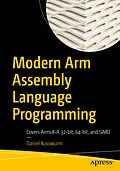Gain the fundamentals of Armv8-A 32-bit and 64-bit assembly language programming. This book emphasizes Armv8-A assembly language topics that are relevant to modern software development. It is designed to help you quickly understand Armv8-A assembly language programming and the computational resources of Arm's SIMD platform. It also contains an abundance of source code that is structured to accelerate learning and comprehension of essential Armv8-A assembly language constructs and SIMD programming concepts. After reading this book, you will be able to code performance-optimized functions and algorithms using Armv8- A 32-bit and 64-bit assembly language.
Modern Arm Assembly Language Programming accentuates the coding of Armv8-A 32-bit and 64-bit assembly language functions that are callable from C++. Multiple chapters are also devoted to Armv8-A SIMD assembly language programming. These chapters discuss how to code functions that are used in computationally intense applications such as machine learning, image processing, audio and video encoding, and computer graphics.
You will:
- See essential details about the Armv8-A 32-bit and 64-bit architectures including data types, general purpose registers, floating-point and SIMD registers, and addressing modes
- Use the Armv8-A 32-bit and 64-bit instruction sets to create performance-enhancing functions that are callable from C++
- Employ Armv8-A assembly language to efficiently manipulate common data types and programming constructs including integers, arrays, matrices, and user-defined structures
- Create assembly language functions that perform scalar floating-point arithmetic using the Armv8-A 32-bit and 64-bit instruction sets
- Harness the Armv8-A SIMD instruction sets to significantly accelerate the performance of computationally intense algorithms in applications such as machine learning, image processing, computer graphics, mathematics, and statistics.
- Apply leading-edge coding strategies and techniques to optimally exploit the Armv8-A 32-bit and 64-bit instruction sets for maximum possible performance
Autorentext
Daniel Kusswurm has over 35 years of professional experience as a software developer and computer scientist. During his career, he has developed innovative software for medical devices, scientific instruments, and image processing applications. On many of these projects, he successfully employed assembly language to significantly improve the performance of computationally intense algorithms or solve unique programming challenges. His educational background includes a BS in electrical engineering technology from Northern Illinois University along with an MS and PhD in computer science from DePaul University. Daniel Kusswurm is also the author of Modern X86 Assembly Language Programming (ISBN-13: 978-1484200650) and Modern X86 Assembly Language Programming, Second Edition (ISBN-13: 978-1484240625), both published by Apress.
Inhalt
Modern Arm Assembly Language Programming
F:\ModArmAsm\Chapters\Outline\ModernArmAsm_Outline (V2).docx Page 1 of 6
Daniel Kusswurm
Introduction
Book overview
Target audience
Content overview
Source code
Terminology and conventions
Additional resources
Chapter 1 Armv8-32 Architecture
Armv8-32 Overview
Data types
Fundamental data types
Numerical data types
SIMD data typesInternal architecture
General-purpose register file
Application Program Status Register (APSR)
Instruction set overview
Instruction operands
Memory addressing modes
Chapter 2 Armv8-32 Core Programming Part 1
Integer arithmetic
Addition and subtraction (Ch02_01)
Multiplication (Ch02_02)
Division (Ch02_03)
Integer operations
Load instructions (Ch02_04)
Move instructions (Ch02_05, Ch02_06)
Logical operations (Ch02_07)Chapter 3 Armv8-32 Core Programming Part 2
Basic stack arguments
Stack arguments (Ch03_01)
Stack arguments using mixed data types (Ch03_02)
Advanced stack use
Modern Arm Assembly Language Programming
F:\ModArmAsm\Chapters\Outline\ModernArmAsm_Outline (V2).docx Page 2 of 6Daniel Kusswurm
Stack use with local storage (Ch03_03)
Stack use with frame pointer (Ch03_04)
Using the APSR condition flags
Compare instructions (Ch03_05)
Looping (Ch03_06)
Chapter 4 Armv8-32 Core Programming Part 3Integer arrays
Array arithmetic (Ch04_01)
Array arithmetic using mixed-type integers (Ch04_02)
Integer matrices
Matrix example #1 (Ch04_03)
Matrix example #2 (Ch04_04)
Advanced programming Advanced array operations (Ch04_05)
Structures (Ch04_06)
Chapter 5 Armv8-32 Floating-Point Architecture
Floating-point programming concepts
Binary encodings
NaNs
Denormals
Flush to zero
Floating-point registers
Single-precision registers
Double-precision registers
FPSCR (floating-point status and control register)
Rounding modes
Exceptions
Chapter 6 Armv8-32 Floating-Point ProgrammingFloating-point arithmetic
FP arithmetic example #1 (Ch06_01)
FP arithmetic example #2 (Ch06_02)
FP arithmetic example #3 (Ch06_03)
Floating-point compares and conversions
FP compares (Ch06_04)
FP conversions (Ch06_05)Floating-point arrays and matrices
Modern Arm Assembly Language Programming
F:\ModArmAsm\Chapters\Outline\ModernArmAsm_Outline (V2).docx Page 3 of 6
Daniel Kusswurm
FP arrays (Ch06_06)
FP matrices (Ch06_07)
Advanced floating-point programmingUsing C++ floating-point library functions (Ch06_08)
Chapter 7 Armv8-32 SIMD Architecture
Armv8-32 SIMD Architecture Overview
SIMD programming concepts
Wraparound and saturated arithmetic
SIMD architecture
Register setsData types
SIMD arithmetic operations
Packed integer arithmetic
Packed floating-point arithmetic
Chapter 8 Armv8-32 SIMD Integer Programming
Packed integer arithmetic
Addition and subtraction (Ch08_01)
Multiplication (Ch08_02)
Shift and logical operations (Ch08_03)
Packed integer image processing
Pixel minimum and maximum (Ch08_04)
Mean intensity (Ch08_05)
<...
